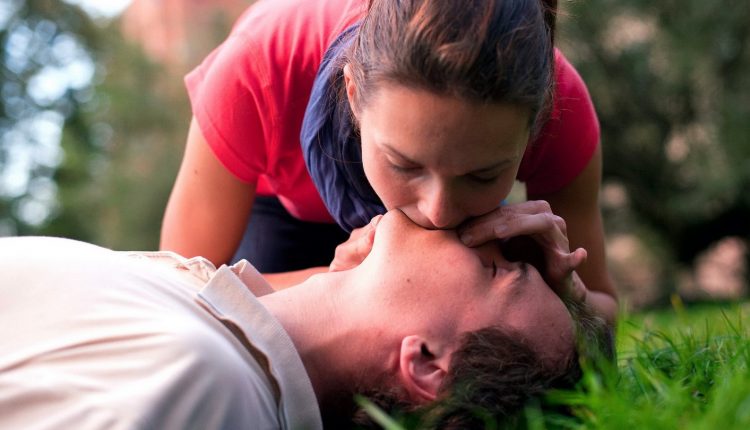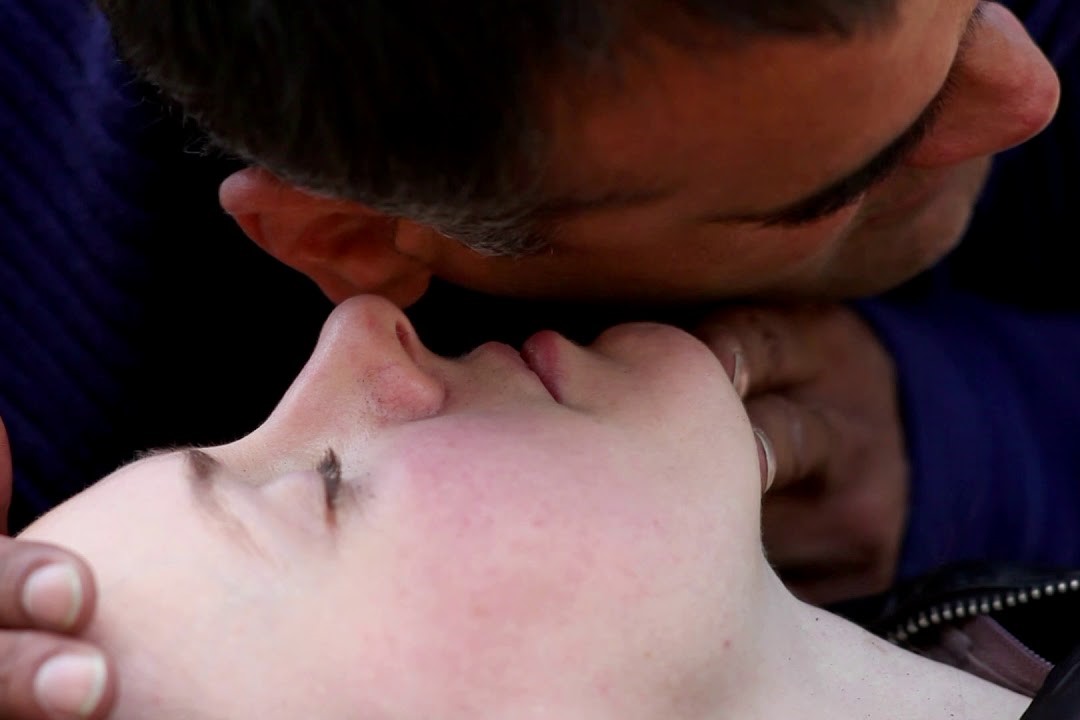
Mouth-to-mouth resuscitation: when to do it and how to do it
Mouth-to-mouth resuscitation is a medical technique that is part of the artificial respiration techniques that, together with other methods, enables BLS, which stands for ‘Basic Life Support’ (basic support for vital functions), i.e. a set of actions that enable first aid to be given to individuals who have suffered a trauma, e.g. car accident, cardiac arrest or electrocution
BLS includes several components:
- assessment of the scene
- assessment of the subject’s state of consciousness;
- call for help by telephone;
- ABC (assessment of airway patency, presence of breathing and cardiac activity);
- cardiopulmonary resuscitation (CPR): consisting of cardiac massage and mouth-to-mouth breathing;
- other basic life support actions.
Assessing the state of consciousness
In emergency situations, the first thing to do – after assessing that the area poses no further risk to the operator or the casualty – is to assess the subject’s state of consciousness:
- stand close to the body;
- the person should be shaken very lightly by the shoulders (to avoid further injury);
- the person must be called out loud (remembering that the person, if unknown, may be deaf);
- if the person does not react, then he/she is defined as unconscious: in this case, no time should be wasted and an immediate request should be made to those close by to call the medical emergency telephone number 118 and/or 112;
in the meantime start the ABCs, i.e:
- check whether the airway is clear of objects obstructing breathing;
- checks whether breathing is present;
- check whether cardiac activity is present via carotid (neck) or radial (pulse) pulse;
- in the absence of breathing and cardiac activity, initiate cardiopulmonary resuscitation (CPR) manoeuvres.
If available, use an automatic/semi-automatic defibrillator, capable of assessing the cardiac alteration and the possibility of delivering the electrical impulse to perform cardioversion (return to a sinus rhythm, i.e. normal).
On the other hand, do not use a manual defibrillator if you are not a doctor: it could make the situation worse.
TRAINING: VISIT THE BOOTH OF DMC DINAS MEDICAL CONSULTANTS IN EMERGENCY EXPO
Mouth-to-mouth breathing
For every 30 compressions of cardiac massage, it is necessary to give 2 insufflations with artificial respiration (ratio 30:2).
Mouth-to-mouth respiration consists of these steps:
- Lay the casualty in a supine position (belly up).
- The casualty’s head is rotated backwards.
- Check the airway and remove any foreign bodies from the oral cavity.
If trauma is NOT suspected, lift the jaw of the casualty by bending the head backwards: this prevents the casualty’s tongue from blocking the airway.
If spinal trauma is suspected, do not make any reckless movements: they may make the situation worse.
Close the victim’s nostrils with your thumb and forefinger. Caution: forgetting to close the nose will render the whole operation ineffective!
Inhale normally and insufflate air through the mouth (or if this is not possible, through the nose) of the casualty, checking that the rib cage is raised.
Repeat at a rate of 15-20 breaths per minute (one breath every 3 to 4 seconds).
It is essential that the head remains hyperextended during mouth-to-mouth insufflations.
An incorrect airway position exposes the victim to the risk of air entering the stomach, thus easily causing regurgitation.
The latter is also caused by the power with which one blows: blowing too hard sends air into the stomach.
Mouth-to-mouth respiration involves the forced insufflation of air into the casualty’s respiratory system, with the help of a mask or mouthpiece.
In the likely absence of a mask or mouthpiece, a filter barrier consisting of a light cotton handkerchief can be used to protect the rescuer from direct contact with the casualty’s mouth, especially if the latter has bleeding wounds.
The new guidelines of 2010 warn the rescuer of the risks of hyperventilation: excessive increase in intrathoracic pressure, risk of insufflation of air into the stomach, reduced venous return to the heart; for this reason, insufflations should not be excessively vigorous, but should emit an amount of air no greater than 500-600 cm³ (half a litre, in a time not exceeding one second).
The air inhaled by the rescuer before insufflation should be as ‘pure’ as possible, i.e. it should contain as high a percentage of oxygen as possible: for this reason, the rescuer should raise his or her head between insufflations to inhale at a sufficient distance so that he or she does not inhale the air emitted by the victim, which has a lower oxygen density, or his or her own (rich in carbon dioxide).
Resuscitation must always begin with compressions except in the case of trauma or if the victim is a child: in these cases we start with 5 insufflations, and continue normally with alternating compressions-insufflations.
This is because, in the case of trauma, it is assumed that there is not enough oxygen in the victim’s lungs to ensure efficient blood circulation; all the more reason, as a precautionary measure, to start with insufflations if the victim is a child, since it is presumed that a child, enjoying good health, is in a state of cardiac arrest due to causes more likely to be caused by trauma or a foreign body that has entered the airways.
In the event of a simultaneous lack of heartbeat, after every 30 compressions of cardiac massage, the caregiver – if alone – will interrupt the massage to give 2 insufflations with artificial respiration (mouth-to-mouth or with a mask or mouthpiece).
At the end of the second insufflation, immediately resume with cardiac massage.
The ratio of cardiac compressions to insufflations – in the case of a single operator – is therefore 30:2.
If there are two operators, artificial respiration can instead be performed at the same time as cardiac massage.
When not resuscitating?
Non-medical rescuers (those who are usually on the ambulances) can only ascertain death, and thus not initiate manoeuvres, only
- in the case of externally visible, decerebrate brain matter (in the case of trauma, for example);
- in the case of decapitation ;
- in the case of injuries totally incompatible with life ;
- in the case of a charred subject
- in the case of a subject in rigor mortis .
New changes in the A.H.A. manuals on mouth-to-mouth respiration
The most recent changes (as can be verified in the A.H.A. manuals) concern order rather than procedures.
Firstly, the emphasis on early cardiac massage, which is considered more important than early oxygenation, has increased.
The sequence has therefore changed from ABC (open airway, breathing and circulation) to CAB (circulation, open airway and breathing):
- one starts with the 30 chest compressions (which must begin within 10 seconds of recognition of the heart block);
- you proceed to the airway opening manoeuvres and then to ventilation.
This only delays the first ventilation by about 20 seconds, which does not adversely affect the success of CPR.
In addition, the GAS phase has been eliminated (in the victim’s assessment) because agonised breathing (gasping) may be present, which is felt by the rescuer both as a sensation of breath on the skin (Sento) and audibly (Ascolto) but which does not result in effective lung ventilation because it is spasmodic, shallow and very low frequency.
Minor changes concern the frequency of chest compressions (from about 100/min to at least 100/min) and the use of cricoid pressure to prevent gastric insufflation: cricoid pressure should be avoided as it is not effective and can prove harmful by making the insertion of advanced respiratory devices such as endotracheal tubes etc. more difficult.
Lateral safety position
If breathing returns, but the patient is still unconscious and no trauma is assumed, the patient should be placed in the lateral safety position.
This is done by bending one knee and bringing the foot of the same leg under the knee of the opposite leg.
The arm opposite the flexed leg must be slid across the ground until it is perpendicular to the torso.
The other arm should be placed on the chest, so that the hand passes over the side of the neck.
Next, the rescuer should stand on the side that does not have the arm extended outwards, put his or her arm between the arch formed by the patient’s legs, and with the other grasp the head.
Using their knees, gently roll the patient onto the side of the outer arm, accompanying the movement of the head.
The head should then be hyperextended and held in this position by placing the hand of the arm that is not touching the ground under the cheek.
The purpose of this position is to keep the airway clear and prevent sudden jets of vomit from occluding the respiratory cavity and entering the lungs, damaging their integrity.
With the lateral safety position, any fluid emitted is expelled out of the body.
RESCUE WORKERS’ RADIO IN THE WORLD? VISIT THE EMS RADIO BOOTH AT EMERGENCY EXPO
First aid in children and infants: the differences in mouth-to-mouth and paediatric BLS
The method for BLS in children aged 12 months to 8 years is similar to that used for adults.
However, there are differences, which take into account the lower lung capacity of children and their faster breathing rate.
In addition, it must be remembered that compressions must be less deep than in adults.
One starts with 5 insufflations, before proceeding to cardiac massage, which has a ratio of compressions to insufflations of 15:2.
Depending on the corpulence of the child, compressions can be performed with both limbs (in adults), one limb only (in children), or even just two fingers (index and middle fingers at the level of the xiphoid process in infants).
Lastly, it should be remembered that, since the normal heart rate in children is higher than in adults, in the presence of a child presenting circulatory activity with a heart rate below 60 pulses/min, one should act as in the case of cardiac arrest.
Read Also:
Emergency Live Even More…Live: Download The New Free App Of Your Newspaper For IOS And Android
Compensated, Decompensated And Irreversible Shock: What They Are And What They Determine
Drowning Resuscitation For Surfers
First Aid: When And How To Perform The Heimlich Maneuver / VIDEO
First Aid, The Five Fears Of CPR Response
Perform First Aid On A Toddler: What Differences With The Adult?
Heimlich Maneuver: Find Out What It Is And How To Do It
Chest Trauma: Clinical Aspects, Therapy, Airway And Ventilatory Assistance
Internal Haemorrhage: Definition, Causes, Symptoms, Diagnosis, Severity, Treatment
How To Carry Out Primary Survey Using The DRABC In First Aid
Heimlich Maneuver: Find Out What It Is And How To Do It
What Should Be In A Paediatric First Aid Kit
Poison Mushroom Poisoning: What To Do? How Does Poisoning Manifest Itself?
Hydrocarbon Poisoning: Symptoms, Diagnosis And Treatment
First Aid: What To Do After Swallowing Or Spilling Bleach On Your Skin
Signs And Symptoms Of Shock: How And When To Intervene
Wasp Sting And Anaphylactic Shock: What To Do Before The Ambulance Arrives?
Spinal Shock: Causes, Symptoms, Risks, Diagnosis, Treatment, Prognosis, Death
Cervical Collar In Trauma Patients In Emergency Medicine: When To Use It, Why It Is Important
KED Extrication Device For Trauma Extraction: What It Is And How To Use It
Introduction To Advanced First Aid Training
Drowning Resuscitation For Surfers
The Quick And Dirty Guide To Shock: Differences Between Compensated, Decompensated And Irreversible
Dry And Secondary Drowning: Meaning, Symptoms And Prevention
First Aid: Definition, Meaning, Symbols, Objectives, International Protocols




